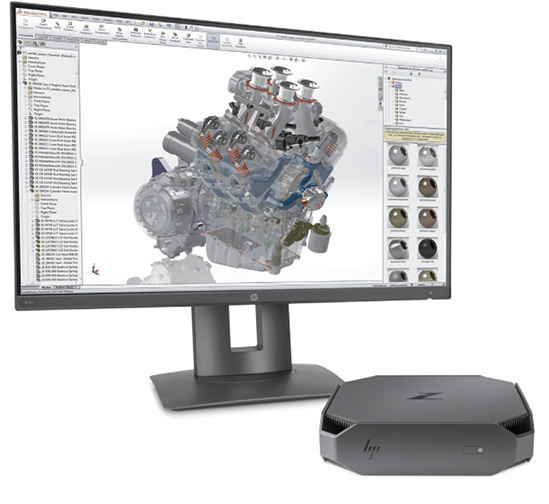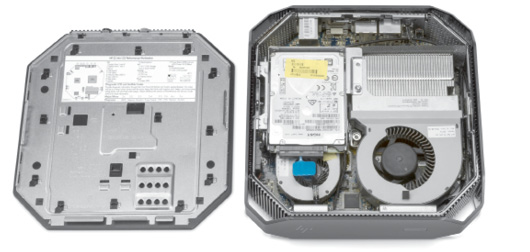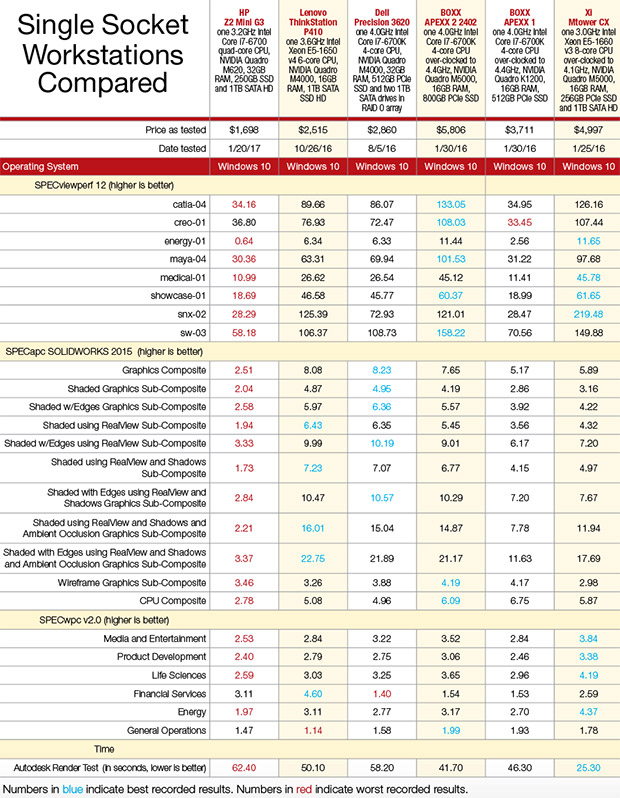HP Z2 Mini Workstation Review: Small and Beautiful

June 1, 2017
HP consistently distinguishes itself as a technology leader. Nowhere was this more apparent than when the new HP Z2 Mini G3 workstation recently arrived in our office for review. First unveiled at Autodesk University, the Z2 Mini is billed as the first mini workstation designed for CAD users. As its name implies, the HP Z2 Mini is tiny, measuring just 8.5x8.5x2.25 in. and weighing a scant 4.85 pounds—more like a thin client than a full-fledged workstation. Yet, the diminutive system is packed with workstation features.
Why create such a small system? Desktop space is at a premium. In addition to being able to sit on a desk in either a horizontal or vertical orientation, the HP Z2 Mini can be mounted under your desk, behind your monitor or on a display arm. HP sells a VESA mounting sleeve with standard VESA mounting holes that, when rotated, can enhance security by blocking access to USB ports.
The system is enclosed in a charcoal gray metal case with its corners beveled at 45° angles. Grills behind the bevel in each corner allow the airflow necessary to cool all of the components packed inside. Because its small size leaves no room for a conventional power supply, the Z2 Mini requires an external power brick, similar to a laptop. Like the system itself, however, the 200-watt power supply included with our evaluation unit was also small, measuring 6.75x3.75x1.0 in. and weighing 2.12 pounds.
When positioned horizontally, the front of the case sports only a power button and the HP logo, whereas the left side includes a pair of USB 3.0 Type A ports and a combination headphone/microphone jack connected to the built-in audio that drives a pair of 2-watt speakers. All other connections are on the rear panel and include an RJ45 network jack, two additional USB 3.0 Type A ports, two USB 3.1 Type C ports, four DisplayPorts, a security lock slot and the external power supply connection. You can connect up to six monitors. When the system is out of reach, it can be powered on using the keyboard or mouse.
Packed with Power
As with any workstation, it’s what’s inside that counts. Again HP makes no compromises. A slide on the rear panel releases the top cover, providing tool-less access to the interior. Inside, a 1TB 7200rpm hard drive—standard in the base configuration—partially conceals the expansion slots, whereas a metal plate and adjacent fan cover the CPU and memory sockets.
The HP Z2 Mini is based on an Intel C236 chipset and supports Intel Xeon E3-1200v5 and Intel Core processors. With a starting price of $699, the entry-level configuration uses an Intel Core i3-6100 3.7GHz dual core CPU. For our evaluation unit, however, HP included a Core i7-6700 processor, which adds $350 to the base price. This 3.2GHz Skylake CPU has a 4.0GHz maximum turbo speed and includes 8MB Smart Cache and Intel HD Graphics 530. HP also offers a choice of five other CPUs.
The base configuration does not include a discrete CPU, but our evaluation unit came with an NVIDIA Quadro M620 CPU. This Maxwell-based graphics card, with 2GB of GDDR5 memory and 512 CUDA parallel processing cores, features a 128-bit interface and 80GB/sec memory bandwidth. This is the only discrete GPU offered and adds $199 to the system cost.
The HP Z2 Mini has two SO-DIMM (small outline dual in-line memory module) sockets, and HP includes 8GB of RAM in the base configuration. Our evaluation unit was equipped with 32GB, installed as a pair of 16GB 2133MHz modules. Newer systems now include 2400MHz memory.
 The new HP Z2 Mini G3 packs workstation performance into a deceptively tiny case that makes it easy to access the interior. Images courtesy of HP.
The new HP Z2 Mini G3 packs workstation performance into a deceptively tiny case that makes it easy to access the interior. Images courtesy of HP.In addition to the standard SATA drive, the HP Z2 Mini supports an M.2 PCIe drive. Our evaluation unit included a 256GB HP Z Turbo Drive and the OS was preloaded onto this solid-state drive. An integrated gigabit LAN is also standard, but our evaluation unit included an Intel dual band wireless AC 82655 module providing 802.11ac wireless plus Bluetooth 4.2.
Decent Performance
Although the HP Z2 Mini performed well in all of our benchmarks, with its modest GPU, its results were more comparable with mobile workstations than desktop systems. On the SPECviewperf tests, the Z2 Mini lagged behind all of the other desktop systems we have tested recently, including the diminutive BOXX APEXX 1 we reviewed last year. This also proved to be true on the SPEC SolidWorks 2015 benchmark.
We also ran the demanding SPECwpc workstation performance benchmark. Here, the performance of the Z2 Mini was a mixed bag. Results based primarily on CPU and I/O were good, though it lagged behind on those tests focused primarily on GPU performance. The system remained cool and relatively quiet throughout our tests. HP claims that the Z2 Mini is 63% quieter than an HP business-class PC, but the sound level during our tests averaged 42dB while running more intensive benchmarks and climbed as high as 50dB.
Although HP rounds out the base configuration with a USB keyboard and mouse, our review unit came with a 104-key HP wireless keyboard and mouse. A USB stick provides wireless access for the keyboard and mouse. The system came preloaded with Windows 10 Professional 64-bit. Windows 7 Professional is also available through downgrade rights from Windows 10 Pro, or you can save $177 and purchase a Linux-ready system without a preloaded OS.
Like other HP professional Z-series workstations, the Z2 Mini G3 is certified for more than 20 critical applications including AutoCAD and SOLIDWORKS, and is backed by a three-year warranty that covers parts, labor and on-site service.
The new HP Z2 Mini G3 offers flexibility and workstation performance in an inventive design. It is a beautiful example of form and function, with a price guaranteed to place it discretely on (or under) the desks of many DE readers.
For more info:
HP Z2 Mini G3
- Price: $1,698 as tested ($699 base price)
- Size: 8.5x8.5x2.25 in. (WxHxD) notebook
- Weight: 4.85 pounds (plus 2.12-pound external power supply)
- CPU: Intel Core i7-6700 3.2GHz quad-core w/ 8MB cache
- Memory: 32GB DDR3 2133MHz
- Graphics: NVIDIA Quadro M620 w/2GB GDDR5 and Intel HD Graphics P530
- Hard Disk: 250GB PCIe M.2 SSD and 1TB 7200rpm SATA
- Floppy/Optical/Video/Modem: none
- Audio: integrated with 2-watt speakers
- Network: integrated Intel i219-LM gigabit network; integrated dual-band wireless 802.11a/b/g/n/ac Wi-Fi; Bluetooth 4.0
- Other: four USB 3.0, two USB Type C 3.1 ports, (one with charging), HDMI 4.1, microphone-in/headphone-out combo, A/C power, RJ-45, two Thunderbolt 3.1, smart card reader
Subscribe to our FREE magazine, FREE email newsletters or both!
About the Author
David Cohn is a consultant and technical writer based in Bellingham, WA, and has been benchmarking PCs since 1984. He is a Contributing Editor to Digital Engineering, the former senior content manager at 4D Technologies, and the author of more than a dozen books. Email at [email protected] or visit his website at www.dscohn.com.
Follow DE







